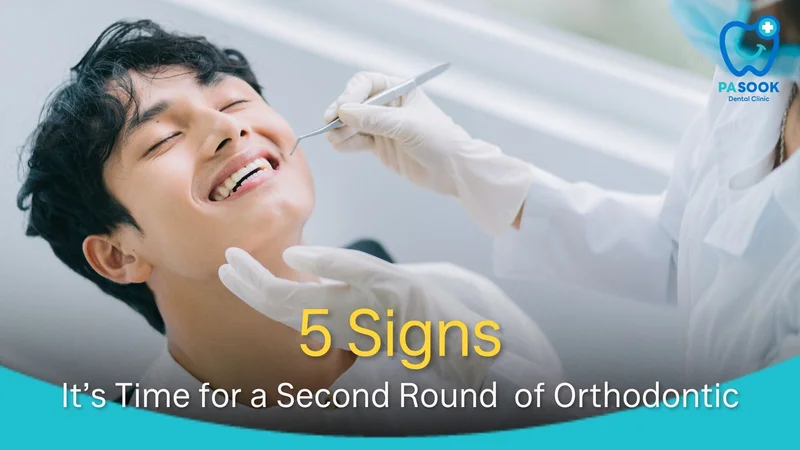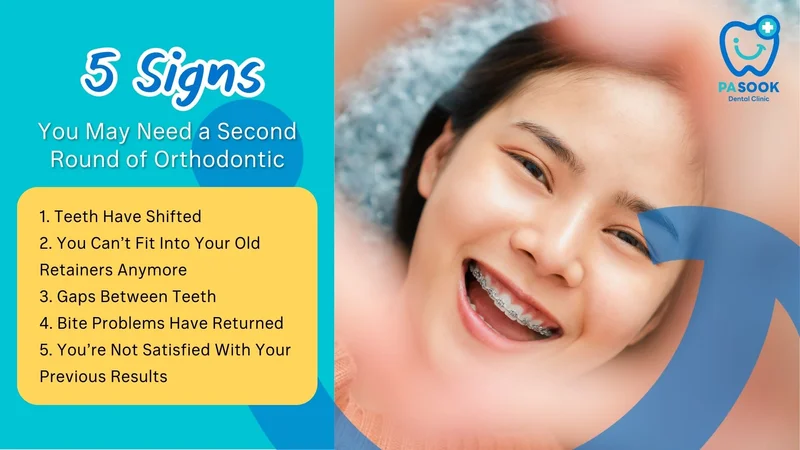5 Signs It’s Time for a Second Round of Orthodontic

5 Signs Its Time for a Second Round of Orthodontic

Sometimes, the first round of orthodontic doesn't deliver the long-term results you expectedespecially if retainers were neglected or other factors caused teeth to shift. Thats why a second round of braces has become a practical solution for many people looking to regain a confident, well-aligned smile.
Table of Contents
1.What Is a Second Round of Orthodontics?
2.5 Signs You May Need a Second Round of Orthodontic
3.Who Should Consider a Second Round of Orthodontic Treatment?
4.Is Clear Aligners a Good Choice for Your Second Round of Orthodontics?
What Is a Second Round of Orthodontics?

If youve had braces before but notice your teeth shifting or feel dissatisfied with your smile, dont worry. A second round of orthodontics can help you realign your teeth efficiently. Because your teeth have already been partially moved, treatment time and costs are often less than the initial round.
However, its important to consult a trusted dental clinic and an experienced orthodontist. Proper planning and following your dentists adviceespecially about wearing retainers regularly will ensure the best long-term results.
With proper planning and consistent retainer use, you can restore long-term alignment and regain a confident, healthy smile.
5 Signs You May Need a Second Round of Orthodontic

1. Teeth Have Shifted or Become Misaligned Again
One of the most common reasons people consider a second round of orthodontic is orthodontic relapse especially due to irregular or discontinued retainer use. This can cause teeth to drift, flare, or tip inward often referred to as "falling teeth". Not only does this affect the aesthetic of your smile, but it may also impact your bite, chewing function, and long-term gum health.
2. You Cant Fit Into Your Old Retainers Anymore
If your old retainers feel tight, uncomfortable, or cant be worn anymore, its a sign your teeth have moved from their ideal position. This could mean your previous results are no longer stable and you should consult your orthodontist to determine if a second round is needed.
3. Gaps Between Teeth and Food Getting Stuck Often
Teeth that used to be perfectly aligned may start developing small gaps. This can lead to food getting stuck frequently, plaque buildup, bad breath, or even tooth decay. If you notice youre flossing more often or feel discomfort after meals, it could be time to reassess your dental alignment.
4. Bite Problems Have Returned (Malocclusion such as Overbite, Crossbite, etc.)
Bite problems like overbite, crossbite, or open biteknown as malocclusioncan come back even after braces. These issues might cause jaw discomfort, uneven wear on teeth, or make chewing difficult. Seeing your orthodontist early can help prevent further complications.
5. Youre Not Satisfied With Your Previous Results
Sometimes, the outcome from the first round of braces may not fully meet expectations. Whether your teeth never looked as straight as you hoped, or some issues remained uncorrected, a second round of orthodontics offers the opportunity to achieve the ideal result you were aiming for.
Who Should Consider a Second Round of Orthodontic Treatment?
Even if you have had braces before, there are certain cases where a second round of orthodontic treatment may be necessary to correct ongoing or recurring dental issues. The signs or indications that you might need to consider a second round include:
1.Teeth shifting back to their original positions: This often happens due to inconsistent use of retainers after the first orthodontic treatment, causing teeth to gradually move back.
2.Malocclusion (improper bite): Issues such as open bite, deep bite, or crossbite can affect chewing function and overall appearance.
3.Teeth tilting or gaps reopening: Teeth may become crooked or gaps may reappear, impacting your smile and oral hygiene.
4.Previously had fashion braces (non-professional orthodontics): Fashion braces without proper planning or supervision by an orthodontist can lead to poor results or complications.
5.Unsatisfactory results from the first orthodontic treatment: For example, remaining gaps between teeth or wanting to improve facial proportions, such as reducing lip protrusion.
Is Clear Aligners a Good Choice for Your Second Round of Orthodontic?

For those who have had braces before but are still not satisfied with the results, or are experiencing minor issues such as teeth shifting, gaps reopening, or mild crowding returning, a second round of orthodontic treatment can be a great option. Typically, this second round requires less time than the first because your teeth have already been partially aligned.
One of the most popular choices for the second round is "Clear Aligners", which offer numerous benefits that cater to both aesthetics and daily life, including:
- Nearly invisible appliances that do not affect your appearance when smiling or talking
- Removable design that makes oral hygiene easier, reducing the risk of cavities and gum inflammation
- Comfortable to wear with no wires or brackets that can irritate soft tissues like cheeks and gums
- Ability to eat normally without dietary restrictions common with traditional metal braces
- Often lower cost than the first round of orthodontics because fewer adjustments and appliances are needed
For these reasons, many people who need a second round of orthodontic treatment choose clear aligners theyre convenient, discreet, and usually quicker.
If youre still unsure whether a second round of orthodontic treatment is right for you, PASOOK Dental Clinic is here to help. Our orthodontic specialists provide thorough assessments, personalized treatment planning, and attentive care every step of the way to ensure you get a confident and beautiful smile thats truly yours.


